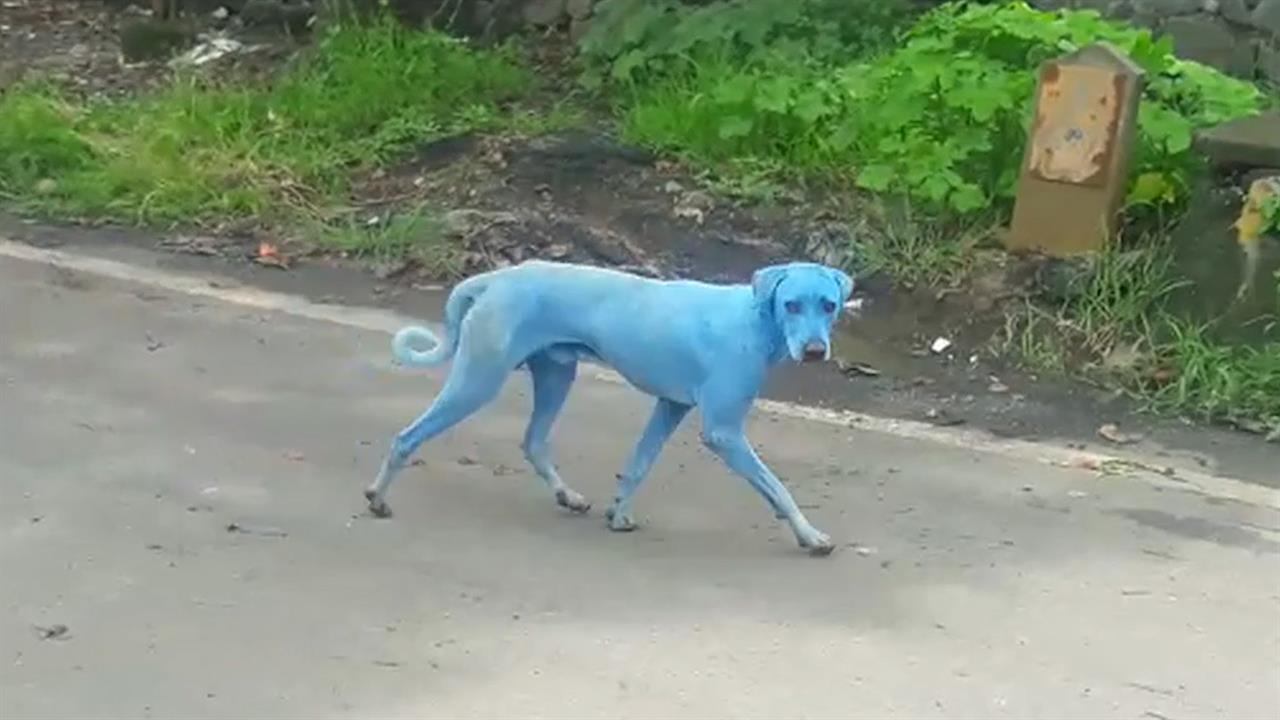When dogs in Taloja, an industrial neighborhood in Mumbai, India, began walking around with bright blue fur, residents took notice.
 Concern about the dogs, and fear that the dye could portend a dangerous pollutant, was quickly evident on social media and in local news reports.
Concern about the dogs, and fear that the dye could portend a dangerous pollutant, was quickly evident on social media and in local news reports.
A representative from the Navi Mumbai Animal Protection Cell (NMAPC), one of the animal clinics that treated the dogs, told National Geographic over the phone that heavy rains have since washed the dogs clean. In an email, Shakuntala Majumdar from Mumbai’s Thane SPCA also said they had caught one of the dogs and were able to clean it up.
While the dogs that have been treated are reportedly fine, their appearance prompts a number of questions, chief among them—how a bunch of dogs turned bright blue.
According to reporting from the Hindustan Times, the dogs were likely affected by untreated industrial waste that had been allegedly dumped by one company into the nearby Kasadi River. The river flows through an area with hundreds of factories, but the Times quoted officials who are blaming one factory whose name has not been released but which allegedly manufactures detergent. An investigation has been opened by the local regulatory agency, the Maharashtra Pollution Control Board, who will reportedly release a full report on the incident in the coming weeks.
The Maharashtra Pollution Control Board did not respond to multiple requests for comment.
BLUE CLUES
Majumdar and his team were initially notified of the blue strays by concerned residents. The factory that locals think may be responsible and water areas surrounding it were fenced off, but the dogs were reportedly able to find holes in the wire fence, where they swam in the water to cool off. The Thane SPCA counted five dogs initially affected but estimate there could be more in the area based on the higher population of strays and the relatively weak fence.
“They looked apparently healthy excepting blotches of blue on their fur,” said Majumdar.
The team struggled to catch the nimble dogs in the marshy area, but were eventually successful in taking one back to their clinic.
“The dye is possibly water based as it washed off after two regular baths,” said the animal care worker.
In addition to baths, the dog’s skin was lightly scraped to test for toxicity. A number of regional outlets have reported that the dogs were found blind, which Majumdar says is false.
“We have not seen any blind dogs.”
A representative from the Navi Mumbai Animal Protection Cell reached similar conclusions about the dye’s toxicity. The have observed no adverse health effects in the dogs or other animals in the region. However, until lab tests on the dogs are finished and the pollution control board releases its report, a judgement on the complete impacts of the dye cannot be made.
MUMBAI’S STRAY DOGS
Dogs are protected by law in India. This past May, the government passed sweeping regulations that ended indiscriminate breeding and provided funding for necessities like food and shelter. In a country with a billion people and 30 million dogs, it’s a massive undertaking.
“They stay on the streets; they are sheltered by small business communities and slum dwellers; most gated communities hate them, but they continue to exist,” remarked Majumdar.
They’re not just existing, says one expert, they’re thriving.
N.G. Jayasimha is the managing director of Humane Society India. He hadn’t heard of the incident in which dogs were turning blue, but he wasn’t surprised that they had been able to access polluted water.
Adding to Majumdar’s comments on the concerned community members who contacted the SPCA, Jayasimha emphasized the important relationship dogs can serve in Mumbai’s communities.
“There are street dogs which do not have personal owners or a referral household but may still be accepted by the neighborhood as belonging to the community,” said Jayasimha.
While dogs can provide an important source of companionship, they also pose a threat as a vector for rabies, often transmit from bites. (Read more about the effort to vaccinate dogs in India.)
According to Humane Society data, 60 percent of India’s dog population falls under the “community owned” status. In Mumbai, over half the city’s human residents are estimated to live on the streets or in slums, and dogs provide companionship while scavenging on trash or other human byproducts.
It’s this scavenging nature, Jayasimha said, that could have led them to rummage around the factory in the first place. A temporary gate has been reportedly installed to block off any additional dogs from entering the waste area.

